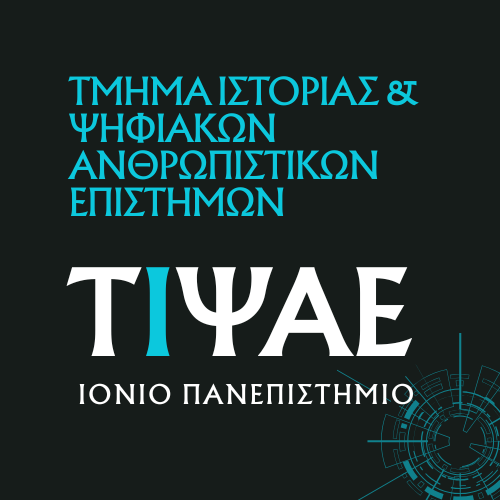PEDAGOGY ΙΙ
Teaching Staff: Angelakos Konstantinos, Kourgiantakis Charalambos
Course Code: ΙΕΑ601
Course Type: Seminar
Course Level: Undergraduate
Course Language: Greek
Delivery method: Lectures
Semester: 6th
ECTS: 5
Curricula: Curriculum in History up to 2024-25, Curriculum in History and Digital Humanities from 2025
The role of audiovisual media and new technologies in the renewal of teaching in general and history in particular will be analyzed through the critical assessment of their enormous potential and the avoidance of their mythology. The following will be studied and presented (with the collaboration of the Informatics Laboratory) ways of exploiting the teaching practice with emphasis on the teaching of the history of modern technological tools, namely (digital) photography, cinematographic image, educational video, educational software CD-ROMs, DVDs, etc.), the internet, digital games, etc.
• The presentation of the multiple sources of information, their history and their use in teaching.
• The evolution of audiovisual literacy and its importance in the field of education in particular.
• The pedagogical dimension of multimedia and especially the Internet in the learning process.
Learning Outcomes to be Achieved
Upon successful completion of the course the student will be able to:
• evaluate sources of information by detecting and highlighting the multiple messages of audiovisual sources.
• select and manage the variety of information, integrating them into the educational process
• develop metacognitive skills to manage new technologies
• Be able to design scenarios and synthesis work using the new technologies
1st week: Summary of the subject and module of the course. Inform students about the work to be done during the academic semester and how they will be evaluated.
2nd week: Educational system - Teaching and utilization of new technological means. The Role of Audiovisual Media and New Technologies in Renewal of Teaching-Theoretical Approaches. Critical evaluation of the possibilities of audiovisual media and new technologies - The danger of mythology.
3rd week: The use of the image in teaching. Categories of animated and still image. The image as a historical testimony to history teaching.
4th week: New Technologies - Film and History: Entertainment and Simulation of Historical Reality. Critical film approach.
5th week: Educational Software - Multimedia in Learning: Learning Theories Using Multimedia. Modelling multimedia educational applications. Evaluation of multimedia educational software: Methods-criteria.
6th week: Educational software-multimedia applications in the history lesson. Multimedia and history teaching. Presentation of educational software for the teaching of school history
7th week: Internet and Teaching: Advantages and Disadvantages – Possibilities and Difficulties. Practical Internet exploitation applications for bibliography and other teaching material inquiry.
8th week: Exploiting the Internet in History Teaching: Internet and Historical Learning. Practical Internet exploitation applications for bibliography and other teaching material inquiry.
9th week: Digital toys and their exploitation in history teaching.
10th week: Interactive teaching: virtual learning environments.
11th week: New technologies and museum education: School and Museum: educational possibilities of the museum. Educational exploitation of new technologies in museum education. Educational multimedia applications from Greek and European museums. Special teaching practice: Toy Museum-Benaki Museum
Week 12 and Week 13: Presentation of work, self-evaluation and evaluation of others
Ανδρέου, A., Iστορία, μουσείο και σχολείο, Δεδούσης, Θεσσαλονίκη1996
Alessi, Stephen M. Πολυμέσα και εκπαίδευση: Μεθοδοι και ανάπτυξη / Stephen M. Alessi , Stanley R. Trollip μετάφραση Χρυσούλα Απ. Κουτρούμπα. - 3η έκδ. - Αθήνα : Γκιούρδας Μ., 2005.
M. Apple, The new technology: Is it part of the solution or part of the problem in education?.
Burk Peter:Αυτοψία. Η χρήση των εικόνων ως ιστορικών μαρτυριών. Μεταίχμιο, Αθήνα 2003.
G. Heba, Hyper-Rhetoric: Multimedia, literacy, and the future of composition.
Α. Δημητρακοπούλου, Πολυμέσα στην Εκπαίδευση.
Κουνέλη, Ευ. (2008), www.Ιστορία για τη γενιά του internet.edu, Ταξιδευτής, Αθήνα.
Λεμονίδου Έλλη, Η Ιστορία στη μεγάλη οθόνη,Ταξιδευτής, 2017,Αθήνα
Stearns, P., Seixas, P., Wineburg, S. (Eds.).), Knowing, teaching, and learning history: national and international perspectives, New York: New York University Press,2000.
Τhomas, S., Minz, A., (ed.), The Virtual and the Real:Media in the Museum, Washington D.C., American, Association of Museums 1998.
Lectures, presentations, interactive discussion, work individually and in groups
Objective: self-action, development of cooperative skills, strengthening of the structural elements of critical thinking (logical reasoning, metacognition).
Support Learning through the e-class e-class platform
Writing work and (oral and electronic) presentation. Final evaluation based on integrated printed and electronic portfolio of work and activities
Back



